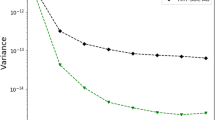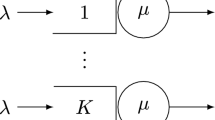Summary
The principle of maximum entropy is used under two different sets of mean value constraints to analyse a stableG/G/1 queue withR priority classes under preemptive-resume (PR) and non-preemptive head-of-line (HOL) scheduling disciplines. New one-step recursions for the maximum entropy state probabilities are established and closed form approximations for the marginal queue length distribution per priority class are derived. To expedite the utility of the maximum entropy solutions exact analysis, based on the generalised exponential (GE) distribution, is used to approximate the marginal mean queue length and idle state probability class constraints for both the PR and HOLG/G/1 priority queues. Moreover, these results are used as building blocks in order to provide new approximate formulae for the mean and coefficient of variation of the effective priority service-time and suggest a maximum entropy algorithm for general open queueing networks with priorities in the context of the reduced occupancy approximation (ROA) method. Numerical examples illustrate the accuracy of the proposed maximum entropy approximations in relation to simulations involving different interarrival-time and service-time distributions per class. Comments on the extension of the work to more complex types of queueing systems are included.
Similar content being viewed by others
References
Baskett, F., Chandy, S.C., Muntz, R.R., Palacios, F.G.: Open, closed and mixed networks of queues with different classes of customers. J. ACM22, 248–260 (1975)
Bondi, B., Chuang, Y.M.: A new MVA based approximation for closed queueing networks with a preemptive priority server. Performance Eval.8, 195–221 (1988)
Bryant, R.M., Krzesinski, E., Seetha Lakshmi, M., Chandy, K.M.: The MVA priority approximation. ACM Trans. Comput. Syst.2, 335–359 (1984)
Buzen, J.P., Denning, P.J.: Measuring and calculating queue length distributions. IEEE Comput.13, 33–44 (1980)
Buzen, J.P., Bondi, A.B.: The response times of priority classes under preemptive resume inM/M/m queues. Oper. Res.31, 456–465 (1983)
Chaudhry, K.M., Templeton, J.G.C.: A first course in bulk queues, 1st Ed. New York: Wiley 1983
Chow, W.M.:M/M/1 priority queues with state dependent arrival and service rates. IBM Thomas J. Watson Res. Center Rept. Re 8570 (1980)
El-Affendi, M.A., Kouvatsos, D.D.: A maximum entropy analysis of theM/G/1 andG/M/1 queueing systems at equilibrium. Acta Inf.,19, 339–355 (1983)
Jaiswal, N.K.: Priority queues, 1st Ed. New York: Academic Press 1968
Jaynes, E.T.: Prior probabilities. IEEE Trans. Syst. Sci. Cyber. SSC4, 227–241 (1968)
Kaufman, J.S.: Approximation methods for networks of queues with priorities. performance Eval.4, 183–198 (1984)
Kelly, F.P.: Reversibility and stochastic networks, 1st Ed. New York: Wiley 1979
Kouvatsos, D.D.: Maximum entropy methods for general queueing networks. Proc. Int. Conf. Modelling Techniques and Tools for Performance Analysis. Potier, D. (ed.), pp. 589–608. Amsterdam: North-Holland 1985
Kouvatsos, D.D.: A maximum entropy analysis of theG/G/1 queue at equilibrium. J. Oper. Res. Soc.39, 183–200 (1988a)
Kouvatsos, D.D., Georgatsos, P.H.E., Tabet-Aouel, N.M.: A universal maximum entropy algorithm for general multiple class open networks with mixed service disciplines. Proc. 4th Int. Conf. on Modelling Techniques and Tools for Computer Performance Evaluation, pp. 473–492. Palma de Mallorca (Balaeric Islands, Spain) Sept. 1988b
Lazowska, E.D., Zahorjan, J., Sevcik, K.C.: Computer systems performance evaluation using queueing network models. Computer Syst. Research Institute, University of Toronto. Tech. Rep. 86-02-07 (1986)
Marks, B.I.: State probabilities ofM/M/1 priority queues. Oper. Res.21, 974–987 (1973)
Miller, D.R.: Computation of steady-state probabilities forM/M/1 priority queues. Oper. Res.29, 945–958 (1981)
Kleinrock, L.: Queueing systems, Vols. 1, 2. New York: Wiley 1975, 1976
Mitrani, I., King, P.J.B.: Multiprocessor systems with preemptive priorities. Perf. Eval., 118–125 (1981)
Neuse, D., Chandy, K.M.: Ham: The heuristic algorithm method for solving general closed queueing models of computer systems. Perf. Eval. Rev.11, 195–1212 (1982)
Sauer, C.: Configuration of computing systems: An approach using queueing network models. PhD Thesis, Univ. of Texas, Austin, USA 1975
Sevcik, K,.C.: Priority scheduling disciplines in queueing network models of computer systems. In: Gilchrist, B. (ed.) Proc. IFIP Congress '77, pp. 565–570. Amsterdam: North-Holland 1977
Shore, J.E., Johnson, R.W.: Axiomatic derivation of the principle of maximum entropy and the principle of minimum cross entropy. IEEE Trans. Inf. Theory.26, 26–37 (1980)
Schmitt, W.: Approximate analysis of markovian queueing networks with priorities. Proc. of 10th Int. Tel. Congress, Montreal 1983
Schmitt, W.: On decompositions of markovian priority queues and their application to the analysis of closed priority queueing networks. In: Gelenbe, E. (ed.) Proc. 10th Int. Symp. on Comp. Perf., pp. 393–407. Amsterdam: North-Holland 1984
Tabet-Aouel, N.: General queueing networks with priorities. Forthcoming PhD Thesis, University of Bradford, 1989
Veran, M, Potier, D., QNAP-2: A portable environment for queueing network modelling. Proc. Int. Conf. on Modelling Techniques and Tools for Performance Analysis, INRIA (1984)
Zahorjan, J., Lazowska, E.D., Sevcik, K.C.: The use of approximations in production performance evaluation software. Proc. Int. Workshop on modelling techniques and performance evaluation. Paris 1987
Author information
Authors and Affiliations
Additional information
This work is sponsored in part by the Science and Engineering Research Council (SERC), UK, under grant GR/D/12422 and in part by the Ministry of Higher Education of the Algerian Government
Rights and permissions
About this article
Cite this article
Kouvatsos, D., Tabet-Aouel, N. A maximum entropy priority approximation for a stableG/G/1 queue. Acta Informatica 27, 247–286 (1989). https://doi.org/10.1007/BF00572990
Received:
Issue Date:
DOI: https://doi.org/10.1007/BF00572990




